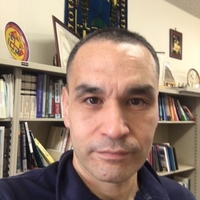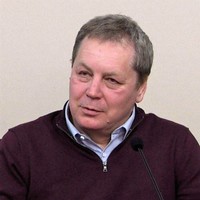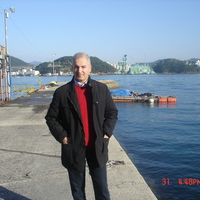
Alexey Ulko
Education:
1999-2000 College of St Mark and St John, Plymouth, UK
Master of Education in Teacher Training for ELT
1986-1991 Samarkand State University, Samarkand, USSR
Diploma (Hon) in English Language Teaching
Completed a range of courses in Teacher Training, Test Development, Materials Writing, Business English and others
IELTS 8.0 (1999), CEELT AAA (1998)
Employment:
2003-present Self-employed international consultant on culture and art of Central Asia and English language
2020-2022 Curator of the CCA Laboratory at the Arts and Culture Development Foundation
2008-2019 Editor of the ELTeCS-Central and South Asia Newsletter (British Council)
1995-2003 Samarkand State Institute of Foreign Languages, Samarkand
Senior Lecturer in English. Taught: Speaking Skills, Literary Analysis, Translation and Interpreting, English Stylistics and Culture
1995-2014 UNESCO International Institute for Central Asian Studies, Samarkand
Consultant and translator
1991-1995 Samarkand City Council, Department of Foreign Trade.
Interpreter and translator
From 2003 to present took part in a wide range of educational projects under the auspices of the British Council: Business English, Educational TV, Resource Centre Management, INSETT and PRESETT Course Development, University Entrance Test Development and others.
From 1993 to present wrote for several newspapers, journals and e-magazines including:
Moscow Art Journal (Russia), Parvina, Panorama, SKV newspapers (Uzbekistan); Kurak journal on art (Kyrgyzstan); Literary almanac ARK (Uzbekistan); STILLS project e-magazine (Kazakhstan); VideoART.uz e-forum (Uzbekistan); Ferghana.ru, Lenta.ru news agencies (Russia)
1999-2000 College of St Mark and St John, Plymouth, UK
Master of Education in Teacher Training for ELT
1986-1991 Samarkand State University, Samarkand, USSR
Diploma (Hon) in English Language Teaching
Completed a range of courses in Teacher Training, Test Development, Materials Writing, Business English and others
IELTS 8.0 (1999), CEELT AAA (1998)
Employment:
2003-present Self-employed international consultant on culture and art of Central Asia and English language
2020-2022 Curator of the CCA Laboratory at the Arts and Culture Development Foundation
2008-2019 Editor of the ELTeCS-Central and South Asia Newsletter (British Council)
1995-2003 Samarkand State Institute of Foreign Languages, Samarkand
Senior Lecturer in English. Taught: Speaking Skills, Literary Analysis, Translation and Interpreting, English Stylistics and Culture
1995-2014 UNESCO International Institute for Central Asian Studies, Samarkand
Consultant and translator
1991-1995 Samarkand City Council, Department of Foreign Trade.
Interpreter and translator
From 2003 to present took part in a wide range of educational projects under the auspices of the British Council: Business English, Educational TV, Resource Centre Management, INSETT and PRESETT Course Development, University Entrance Test Development and others.
From 1993 to present wrote for several newspapers, journals and e-magazines including:
Moscow Art Journal (Russia), Parvina, Panorama, SKV newspapers (Uzbekistan); Kurak journal on art (Kyrgyzstan); Literary almanac ARK (Uzbekistan); STILLS project e-magazine (Kazakhstan); VideoART.uz e-forum (Uzbekistan); Ferghana.ru, Lenta.ru news agencies (Russia)
less
Related Authors
Timur Dadabaev
University of Tsukuba
Mirko Novák
Bern University
Niccolò Pianciola
Università degli Studi di Padova
Gian Luca Bonora
Consiglio Nazionale delle Ricerche (CNR)
Achilov Sharif
Jizzakh State Pedagogical University
InterestsView All (36)










Uploads
Videos by Alexey Ulko
The video was made for the project “As you go… roads under your feet, towards the new future” is initiated and conceived by Biljana Ciric. The inquiry and research cells include What Could Should Curating Do (Belgrade), Moderna Galerija (Ljubljana), Rockbund Art Museum (Shanghai), Guangdong Times Museum (Guangzhou), ArtCom (Astana), Robel Temesgen and Sinkneh Eshetu (Addis Ababa), and The Public Library (Bor).
The first stage of the project has been supported by the Foundation for Arts Initiatives, CURTAIN (Rockbund Art Museum), Austrian Cultural Forum, Curatorial Practice (Monash University Art, Design and Architecture), and and the Australian Government Research Training Program Scholarship.
Papers by Alexey Ulko
Авторство текста установить сложно - хотя он подписан М. с пометкой "с английского", обнаружить англоязычный оригинал или какое-либо упоминание о нем пока не удалось. Однако, особенности текста и употребление имен собственных позволяет предположить, что данный рассказ является очередной литературной мистификацией русскоязычного автора, которых было немало в то время.
the author and recreates a comprehensive biography of the monument. Shakh-i-Zinda, now for the first time, is presented as a complex, multifaceted phenomenon from the medieval culture of Central Asia shown against the backdrop of the history of the region with its political and socioeconomic changes. N.B. Nemtseva carefully follows the stages of structural development, monumental spatial forms, decor, as well as many other aspects of the spiritual and material culture of Maverannahr and its neighboring historical regions over
the past millennium. She identifies several historical, cultural, and chronological stages in the functioning of the Shakh-i-Zinda complex, whose zenith occurred during the era of the Karakhanids (11th-12th centuries) and Timurids (14th-15th centuries), when Samarkand twice acquired the status as the capitals of these empires. These periods were the most active in the ensemble’s construction and associated with the state and socioeconomic stability of the two empires.
The reforms were related to the language policy and more directly involved reducing the number of years of schooling, number of subjects and composition of the educational curriculum. As a result, Turkmenistan has to put much of the economic and political will to reform its education system to overcome the consequences of
the previous drastic experiments. While possessing impressive natural resources and quite a small population of about 5.4 million people, the prospects and potential of the positive reform appears very ambiguous.
The video was made for the project “As you go… roads under your feet, towards the new future” is initiated and conceived by Biljana Ciric. The inquiry and research cells include What Could Should Curating Do (Belgrade), Moderna Galerija (Ljubljana), Rockbund Art Museum (Shanghai), Guangdong Times Museum (Guangzhou), ArtCom (Astana), Robel Temesgen and Sinkneh Eshetu (Addis Ababa), and The Public Library (Bor).
The first stage of the project has been supported by the Foundation for Arts Initiatives, CURTAIN (Rockbund Art Museum), Austrian Cultural Forum, Curatorial Practice (Monash University Art, Design and Architecture), and and the Australian Government Research Training Program Scholarship.
Авторство текста установить сложно - хотя он подписан М. с пометкой "с английского", обнаружить англоязычный оригинал или какое-либо упоминание о нем пока не удалось. Однако, особенности текста и употребление имен собственных позволяет предположить, что данный рассказ является очередной литературной мистификацией русскоязычного автора, которых было немало в то время.
the author and recreates a comprehensive biography of the monument. Shakh-i-Zinda, now for the first time, is presented as a complex, multifaceted phenomenon from the medieval culture of Central Asia shown against the backdrop of the history of the region with its political and socioeconomic changes. N.B. Nemtseva carefully follows the stages of structural development, monumental spatial forms, decor, as well as many other aspects of the spiritual and material culture of Maverannahr and its neighboring historical regions over
the past millennium. She identifies several historical, cultural, and chronological stages in the functioning of the Shakh-i-Zinda complex, whose zenith occurred during the era of the Karakhanids (11th-12th centuries) and Timurids (14th-15th centuries), when Samarkand twice acquired the status as the capitals of these empires. These periods were the most active in the ensemble’s construction and associated with the state and socioeconomic stability of the two empires.
The reforms were related to the language policy and more directly involved reducing the number of years of schooling, number of subjects and composition of the educational curriculum. As a result, Turkmenistan has to put much of the economic and political will to reform its education system to overcome the consequences of
the previous drastic experiments. While possessing impressive natural resources and quite a small population of about 5.4 million people, the prospects and potential of the positive reform appears very ambiguous.
The M-39 was a Soviet modernist project that incorporated various fragments of historic roads from early mediaeval times to the colonial and early Soviet period. The project’s key constructive feature was the introduction of concrete panels which was carried out in several phases in the 1960s-1970s. This significantly increased the road’s capacity for the transportation of large quantities of heavy freight. However, due to considerable differences in the geographical landscape along the motorway, certain sections of the road enjoyed more regular and heavy use than others. The motorway was functioning as a single unit until the mid-1990s, when the previously administrative Soviet boundaries became international borders. Today, the M-39 can be seen as a series of loosely connected fragments that vary tremendously in terms of use.
At the same time, the M-39 can be interpreted as a fascinating journey through the turbulent history, dramatic geography and versatile economy of the region. The motorway traverses diverse cultural and historical landscapes, starting with the 2000 years-old Buddhist temples at Afghanistan’s border, through such medieval Islamic centres as Samarkand, Shakrisabz and Tashkent, ending at the once shamanistic nomadic regions of southern Kazakhstan. It crosses the Great Silk Roads and the route of the Belt and Road Initiative at several points.
The visual essay is dedicated to architectural forms embedded in the physical and cultural landscape surrounding the M-39 motorway. The imagery contains photographs taken by the author, maps and copyright-free historic photos.